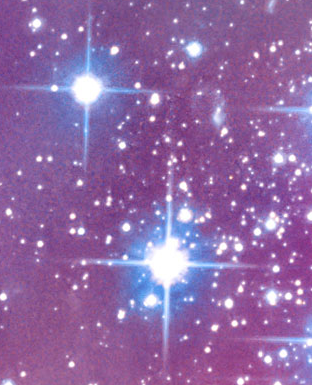Ann wrote:... This cluster is a brilliant illustration of the Initial Mass Function, which says that in a given burst of star formation, mother nature will always make more low-mass than high-mass stars. Look at the central cluster which contains - how many high-mass stars? Seven? Twelve? - how there is an absolute swarm of low-mass stars buzzing about the high-mass ones like bees. ...
Ann
Ann, thanks for your survey of some of the wonders in this image.
The excerpt above brings me to a very very basic astronomy question. I have excerpted the image as well, to part of the region you discussed.

- Capture.png (317.4 KiB) Viewed 1927 times
My first reaction, intuitively from non-astronomical experience, is that the two largest round white discs in the image are "big" stars, and then all of the smaller points of white, some of them still of appreciable size in number of pixels, but then on down to many that look like they're only one or two pixels, is that these are smaller stars, or perhaps stars that are farther away, so they're dimmer or smaller.
But I learned some time ago (from this forum) some facts that change this view. The first thing I learned is that really, if you work it out, Hubble's camera has a certain granularity, as does any camera, and its pixel size is such that every star in this image is so far away that every star in this image, in truth, should occupy less than a pixel, even the biggest, brightest, and closest of them. (Today, I finally did this as a sort of a homework problem: The largest star known,Y Scuti, has a radius of 2.4E+9 km. The Small Magellanic cloud is estimated at 2.0E+5 light years = 1.88E+18km, so that star, at that distance, would subtend a visual angle of -- rounding up -- about one ten-millionth of a degree. I don't know the pixel size on Hubbel's camera, but it can't be anywhere near that small.)
Nevertheless, some of these stars are hitting Hubbel's camera with more photons/time than others. So, there ought to be some way to represent a brighter point light source, compared to a less bright point light source. But how does this work? Does the light bleed into neighboring pixels according to some law? For the larger stars, you can also see a blue aura around them in the image, and of course the diffraction spikes. I could give an explanation of the diffraction spikes. I'm not sure how correct my understanding is. No idea about the blue auras. What causes these?
But back to my main question -- how I should understand and interpret when one star looks bigger than another in a Hubbel image, what is really going on?
 NGC 602 and Beyond
NGC 602 and Beyond


